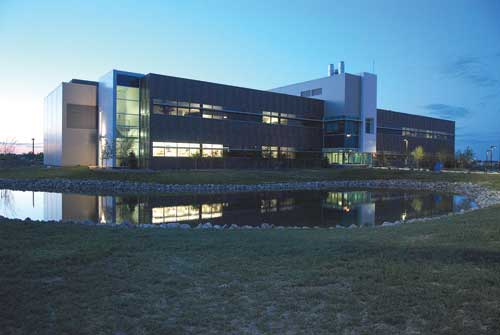The University of Lethbridge is taking a leadership approach in southern Alberta, setting a LEED standard in the design and construction of its new campus buildings.
Beginning with the 1st Choice Savings Centre for Sport and Wellness and continuing with the construction of the Alberta Water and Environmental Science Building (AWESB) and Markin Hall, the U of L is showing that it takes its role in sustainability and environmental responsibility seriously.
"Each building was designed to meet LEED certification, an internationally recognized standard used to judge the environmental performance of buildings," says Brian Sullivan, director, Project Management Office, Facilities. "Beginning with the 1st Choice Savings Centre, we felt it was essential to incorporate specific design elements that would decrease the building's environmental imprint and enhance its sustainability. As we continued along with the construction of the Alberta Water and Environmental Science Building and then Markin Hall, we worked to further improve upon on these techniques."

LEED refers to Leadership in Energy & Environmental Design and uses 70 criteria to gauge the ability of a project to meet rigorous environmental standards established by the Canada Green Building Council in five major categories. They include sustainable sites, water efficiency, energy and atmosphere, materials and resources and indoor environmental quality.
Each project must apply for LEED status and, after being judged, is rated on a point scale. Each of the 1st Choice Savings Centre, AWESB and Markin Hall have been granted LEED Silver status.
"It takes a major commitment to design and construct a building that will stand up to the rigours of the LEED criteria," says Sullivan. "The fact that we've now achieved LEED Silver status on two buildings, with one more in the works speaks to the University's desire to push sustainability principles forward. That also shows in non-LEED certified projects where we are still using LEED standards to drive design."
Following is a look at some of the environmental features incorporated into each building.
1st Choice Savings Centre for Sport and Wellness
• A clerestory window system that brings daylight into the gymnasium to supplement the lighting system
• A low profile project, part of the building is buried in the ground, maximizing the natural insulating characteristics of the earth to reduce utility demand on building systems and reduce the exposure of the building envelope to the elements
• Washrooms and showers throughout the building use dual flush toilets, waterless urinals, controlled flow shower heads and electronic faucets
• Approximately 60 per cent of the building's electricity is purchased from local wind power sources
• The benches in the locker facilities were recycled from the original gymnasium bleacher seats
• The maple flooring in the gymnasium was recycled from the original gymnasium
• Construction included the use of recycled concrete, giving the building 20 per cent recycled content
Alberta Water and Environmental Science Building
• A Living Wall of plants that act as a natural filter and aid in cleansing the air
• An outdoor pond that forms part of a stormwater management strategy, collecting water and circulating it through the westerly wetland, thereby reducing erosion and sedimentation problems in the Oldman River
• Roof water following rainstorms and winter melting is collected and stored in a cistern and recycled into the local irrigation system
• The building employs a heat recovery system in the exhaust air system to reclaim some of the heat that is being exhausted from the building, using it to preheat the incoming supply air
• The building was constructed with a white, highly reflective, energy star rated roof (as were the 1st Choice Savings Centre and Markin Hall) designed to reflect the heat of the sun's rays and reduce the heat island effect, something that is detrimental to animal habitat, wildlife and animal migration
• Created primarily out of steel, a material with a high content of recycled materials, the building consists of 21 per cent recycled content
Markin Hall
• Minimized window-to-wall ratio (40 per cent) to balance thermal control and daylight penetration
• Efficient heat recovery ventilation units that provide 90 per cent latent and sensible heat recovery
• The first radiant cooling application in Alberta
• An energy-conserving building envelope that allows for a smaller and more efficient mechanical system. Together, the building design and mechanical system achieve a predicted 56 per cent energy savings compared to a conventional building
• Other incorporated features include triple-glazed windows, green Label Plus carpeting and polished concrete flooring, low-VOC paints, waterless urinals and low-flow toilets and faucets
This story first appeared in the December 2011 issue of the Legend. If you'd like to see the full issue in a flipbook format, follow this link.
